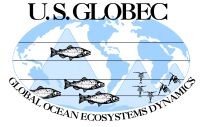August 16, 2002
Final run of the mesoscale survey9:30 a.m.: Another
fine day of SeaSoaring off the south coast of Oregon. Conditions
have improved a bit over the high winds of Thursday evening which has
allowed the bird and mammal team a chance to get back out on deck.
Only a few days are left for the GLOBEC cruise and the science team is
looking forward to making use of the remaining time before returning
to Newport.
.jpg)
Chief Scientist report for 15-16 August 2002
On 15 August, we completed the Fine-Resolution south grid through line
11,
then skipped line 11a and instead dropped down to do line 12 (Crescent
City Line). The South survey showed freshly upwelled water inshore of
about 125 10'W. The only significant surface layer chlorophyll was
restricted to 42.5-43 N and 124 36' to 125 10'W.
We too experienced the gale force winds around Blanco. It was
interesting
to experience the Blanco wind speed bullet. As we headed inshore on
line
10, winds were out of the north at 25 knots increasing to gale force
(35
knots) as we passed the longitude of the Cape. Inshore of that, the
winds
weakened and even reversed! We were in the wind lee behind the Cape. I
haven't spent much time in Gold Beach or Brookings, but the lower
winds
might explain why all those Californians like to retire there :)
We designed a "Mesoscale 2" survey from south to north to hit some of
the
important features we discovered on our previous Mesoscale 1 grid, and
to
also occupy some of the main GLOBEC cross-shelf lines. We finished
line
12 out to warm water at 126 30' (Jack, what are you doing heading so
far
out to sea?) and then did a little zig-zag pattern right through the
center of the cyclonic (counterclockwise) "eddy" we had sampled
earlier.
Still had some chlorphyll in a subsurface maximum around 30m, but
nothing
like we saw a week earlier. Further analysis will allow us to
estimate the fate of shelf material (cold water, nutrients, phyto-
and zooplankton) sent offshore in this feature. We're now headed
inshore
on the western end of line 10 and will be turning north at 125 30' at
1300
PDT to try and intersect the drifters before dusk.
.gif) After
line 8 we'll tow up to line 4 (Heceta Head) and tow from inshore to After
line 8 we'll tow up to line 4 (Heceta Head) and tow from inshore to
offshore on Saturday. So again, another chance for comparisons with
New
Horizon. Steve Pierce and I REALLY want to sample far enough west to
delineate the flow swooping around Heceta Bank (see the green drifter
in
our sst-2002.gif map on the web site). We missed defining this feature
in
Aug '00 and I'd like to check it out more this time. Probably means
sampling to at least 126 30' and maybe out to 127'. I promise to turn
the
ship around and head back to Newport at some point :)
We expect to be on line 1 late on Sunday and at the Newport whistle
buoy
at 0630 Monday morning.
---Jack Barth, Chief Scientist R/V Roger Revelle
filed 1100 PDT August 16 2002
3:30 p.m.: The Revelle is traveling north at
this time on a path that should put the ship near the location of the
drifters this evening. Once the drifters are located, station
work will begin. People on board are taking advantage of the
time this afternoon to catch up on important work.
.jpg) .jpg) .jpg)
8:00 p.m.: The drifters have been located and
the SeaSoar and HTI recovered. After the bio-optical profiler
package cast is complete the CTD/rosette will be lowered. The
wind has eased and the swells have smoothed out for a nice but cool
evening on the Revelle.
.jpg) .jpg) .jpg)
.jpg) .jpg)
Previous update August 15
Next update August 17 |


.jpg)
.gif)
.jpg)
.jpg)
.jpg)
.jpg)
.jpg)
.jpg)
.jpg)
.jpg)

